On Saturday morning, 27 July 2013, I had the pleasure of showing the Mayor of Cologne around the city centre, as part of the 25th anniversary of the sister city relationship between Cork and Cologne.

On Saturday morning, 27 July 2013, I had the pleasure of showing the Mayor of Cologne around the city centre, as part of the 25th anniversary of the sister city relationship between Cork and Cologne.



Kieran’s Our City, Our Town Article,
Cork Independent, 26 July 2012
Mother Jones Commemoration, 31 July-2 August 2012
“My people were poor. For generations they had fought for Ireland’s freedom. Many of my folks have died in that struggle. My father, Richard Harris, came to America in 1835, and as soon as he had become an American citizen he sent for his family. His work as a laborer with railway construction crews took him to Toronto, Canada. Here I was brought up but always as the child of an American citizen. Of that citizenship I have ever been proud” (The Autobiography of Mother Jones, 1925).
Next week sees the start of a commemoration of the life and times of Cork born woman Mary Harris or Mother Jones. She, according to our autobiography, which can be accessed online as well as some of her speeches and some filmed speeches, was an American schoolteacher and dressmaker who became a prominent labour and community organiser, who helped co-ordinate major strikes and co-founded the Industrial Workers of the World.
As a city, I think sometimes we are slow to commemorate the lives of those that left this city, to forge a life elsewhere. I think the story of our Irish emigrants abroad is for the most part absent from the traditional narrative of Irish national history. The remembering of the life and work of Mary Harris is driven by several people who have the Shandon area at heart and who along with others have been delivering great and positive community projects in the form of the Shandon Street Festival and the Dragon of Shandon over several years. I mention both as they reach into the wider city and further afield and draw a focus back on the heart of a great historical area and its multiple histories.
Mary Harris worked as a teacher and dressmaker but after her husband and four children all died of yellow fever and her workshop was destroyed in a fire in 1871 she began working as an organiser for the Knights of Labor and the United Mine Workers union. She was a very effective speaker, punctuating her speeches with stories, audience participation, humor and dramatic stunts. From 1897 (when she was 60) she was known as Mother Jones and in 1902 she was called “the most dangerous woman in America” for her success in organizing mine workers and their families against the mine owners. In 1903, upset about the lax enforcement of the child labour laws in the Pennsylvania mines and silk mills, she organised a Children’s March from Philadelphia to the home of then president Theodore Roosevelt in New York. The publicity arising from this march, which became a large scale media event led eventually to the banning of young children from the mines and mills, where thousands worked in appalling conditions.
Studying such a woman broadens the importance of local history to connecting into a wider narrative, whether in this case Irish emigration history or the history of worker’s rights to an inspiring story. Mary Harris was born in Cork in 1837 and was baptised at the North Cathedral on 1 August 1837, by Fr. John O’Mahony. Her parents were Ellen Cotter, a native of Inchigeela and Richard Harris. Mary’s older brother Richard was born in 1835 in Inchigeela, her sister Catherine was baptized on 29 March 1840 and her brother William was also baptised in the North Cathedral on 28 February 1846. The baptism font in the North Cathedral today may be the one in which Mary Harris was baptised.
Mother Jones was one of the best and most active union organizers ever seen in America. She became a legend among the coalminers of West Virginia and Pennsylvania; Mother Jones was fearless and faced down the guns and court threats of the mine bosses. In 1905 she was the only woman to attend the inaugural meeting of the Industrial Workers of the World (Wobblies). Later she became an organiser for the Socialist Party and continued her defence of workers in industrial disputes across America. She was arrested and jailed in West Virginia for her activities during the Paint Creek, Cabin Creek strikes, but later released following large demonstrations of her supporters. Between 1912 and 1914 she was involved in the “coal wars” of Colorado which led to the infamous Ludlow Massacre, where 19 miners and members of their families were killed. She was imprisoned many times but always released quickly due to huge local support for her activities.
On 1 August 2012, 175 years to the day since she was baptised in Cork, Mother Jones, will be honoured in her native city, when a festival will take place to celebrate her life. The Cork Mother Jones Commemorative Committee in conjunction with the Shandon Street Festival will unveil a plaque, on John Redmond Street at 7.30pm on 1 August. This will form the centerpiece in a series of concerts, exhibitions, lectures, films and music from 31 July to 2 August in Shandon. Speakers will include Professor Elliott Gorn who has written the seminal work on Mother Jones
For more information click on www.motherjones175.wordpress.com; also check out the extensive songs and videos through searching “Mother Jones” on YouTube.
Caption:
A fabulously witty and charming journey into Cork City’s labyrinth that is the English Market – A story that weaves it way through two centuries – overcoming fires, famine, rebellion and war.
http://www.rte.ie/radio1/doconone/radio-documentary-corks-hidden-village-english-market.html
So the day finally arrived; it has been a great week for Ireland; below are some pictures I took today from the crowd of Queen Elizabeth II outside the English Market on the Grand Parade.


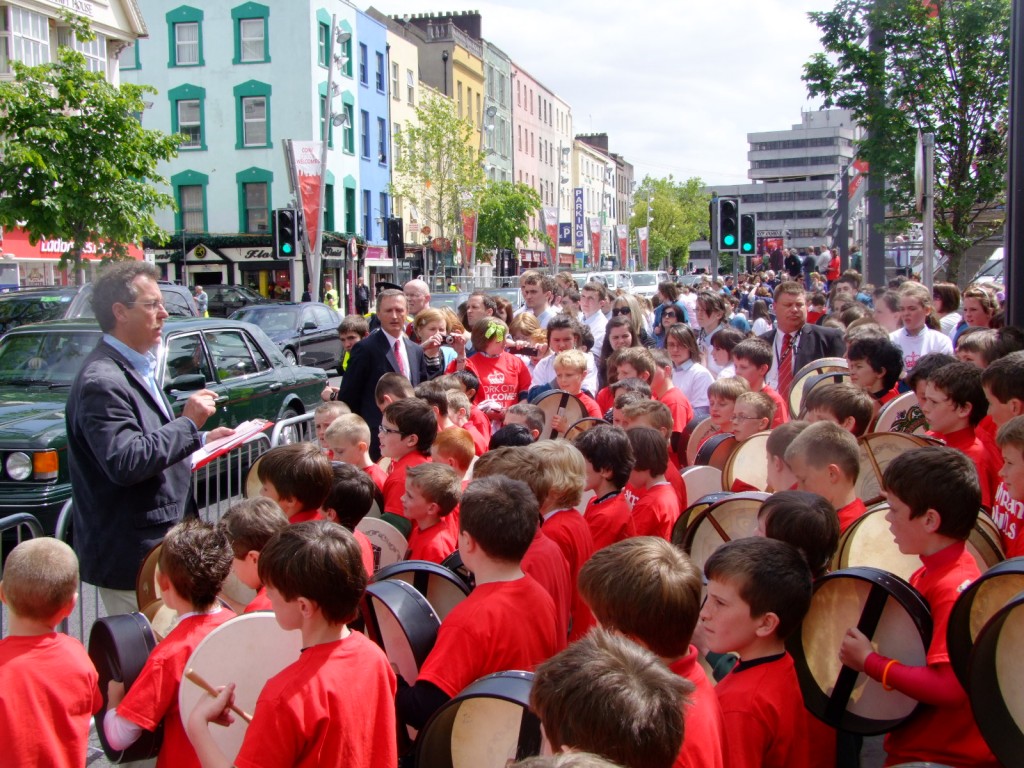
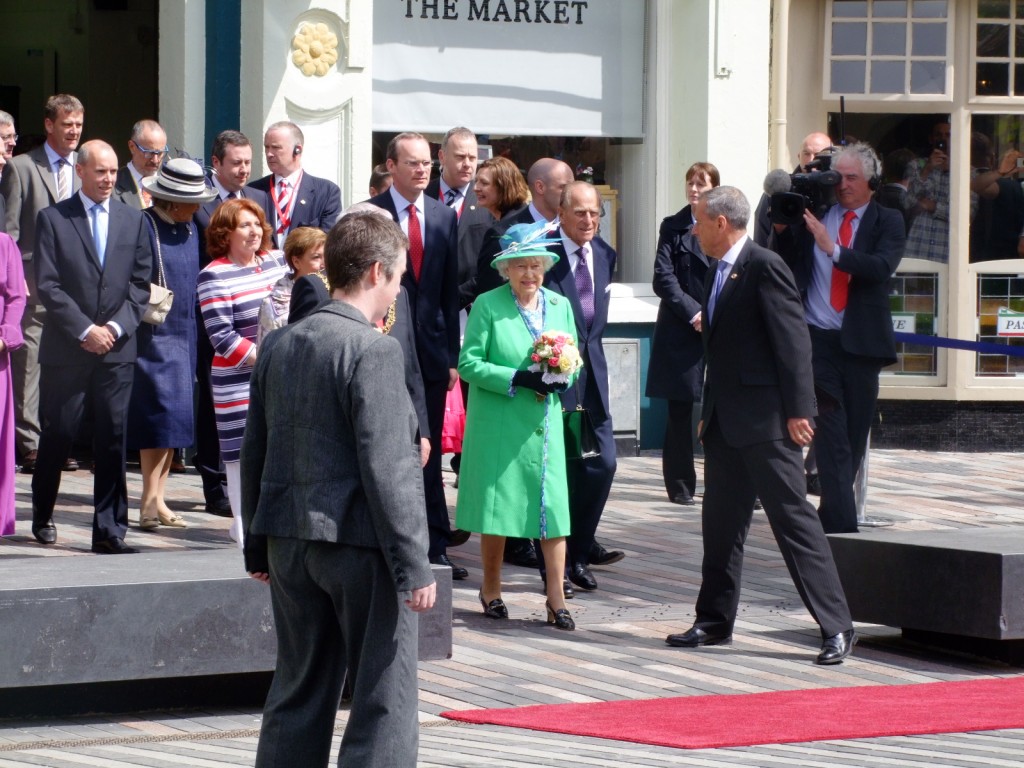
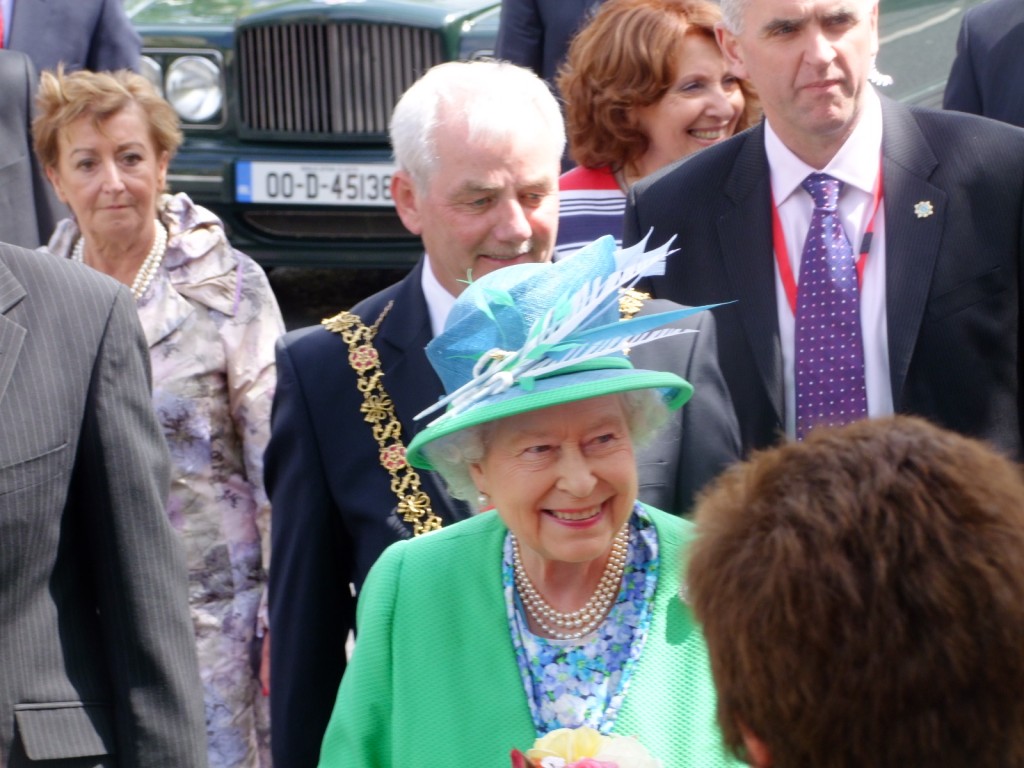
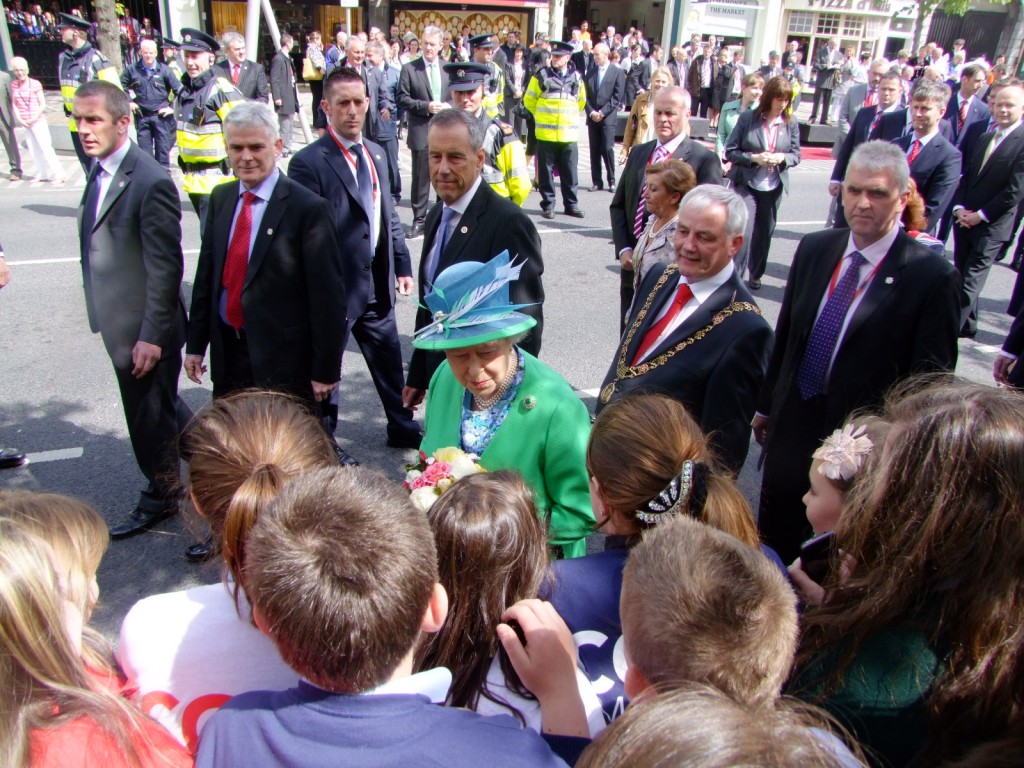
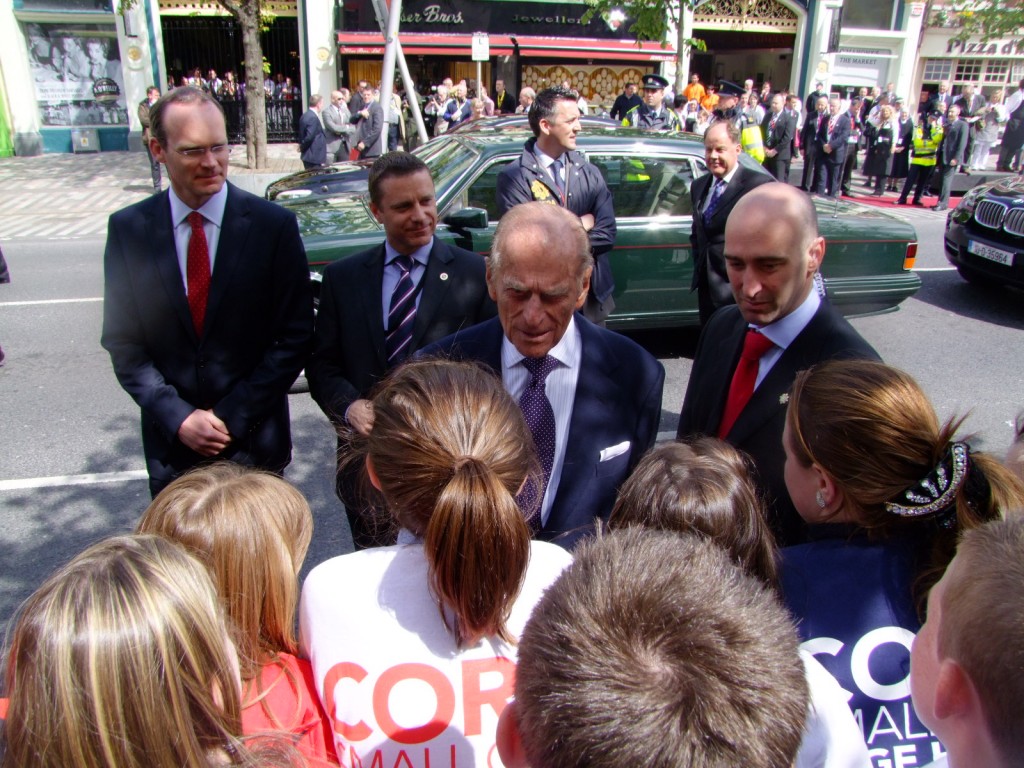

more photos on the Cork: Our City, Our Town facebook page:
http://www.facebook.com/?ref=home#!/pages/Cork-Our-City-Our-Town/169151339802064
 The following is the full text of the remarks on Wednesday, May 18th, 2011 by President Mary McAleese at a State dinner in Dublin Castle in honour of Her Majesty Queen Elizabeth II:
The following is the full text of the remarks on Wednesday, May 18th, 2011 by President Mary McAleese at a State dinner in Dublin Castle in honour of Her Majesty Queen Elizabeth II:
“Your Majesty, Your Royal Highness, Taoiseach, Prime Minister, First Minister, Tanaiste, Foreign Secretary, Distinguished Guests:
It is my pleasure to welcome you to Dublin Castle this evening on this the first ever State Visit to take place between our two countries. This visit is a culmination of the success of the Peace Process. It is an acknowledgment that while we cannot change the past, we have chosen to change the future.
The relationship between our two neighbouring nations is long, complex and has often been turbulent. Like the tides that surround each of us, we have shaped and altered each other. This evening we celebrate a new chapter in our relationship that may still be a work in progress, but happily, has also become a work of progress, of partnership and friendship.
The contemporary British-Irish relationship is multifaceted and strongly underpinned by the most important connection of all — people and families.
Large numbers of British born people live here in Ireland and many more of our citizens have British backgrounds, ancestry and identity. In Britain, those of Irish birth, descent or identity are numbered in millions.
The two way flow of people between these islands goes back millennia. This very room is dedicated to St Patrick, whose name is synonymous with Ireland. Yet he is reputed to have been born in Britain. Patrick’s life as the man who brought Christianity to Ireland is illustrative of the considerable exchange of ideas and knowledge that there has been between our two nations throughout history.
It has been a fascinating two way street with Britain bestowing on Ireland our system of common law, parliamentary tradition, independent civil service, gracious Georgian architecture, love of English literature and our obsession with the Premiership. Conversely, Britain greatly benefitted from the Irish genius of the likes of — Edmund Burke, the Duke of Wellington, Daniel O’Connell, Charles Stuart Parnell, Maria Edgeworth, Oscar Wilde, George Bernard Shaw and even Father Ted. Indeed, it was Shaw who wryly observed that:
“England had conquered Ireland, so there was nothing for it but to come over and conquer England.”
However, even Shaw might not have dared to imagine that this cultural conquest would come in time to include rugby and cricket.
The Irish in Britain and the British in Ireland both as individuals and communities, have made an invaluable contribution to both our homelands while also cementing the links between us.
Today those links provide the foundation for a thriving economic relationship. As close trade and investment partners and as partners in the European Union, Britain and Ireland are essential to each other’s economic wellbeing. It is imperative that we work fluently together to promote the conditions that stimulate prosperity and opportunity for all of our people.
It is only right that on this historic visit we should reflect on the difficult centuries which have brought us to this point. Inevitably where there are the colonisers and the colonised, the past is a repository of sources of bitter division. The harsh facts cannot be altered nor loss nor grief erased but with time and generosity, interpretations and perspectives can soften and open up space for new accommodations.
Yesterday, Your Majesty, you visited our Garden of Remembrance and laid a wreath there in honour of the sacrifice and achievement of those who fought against Britain for Irish independence. Today at Islandbridge, just as we did at the Island of Ireland Peace Park at Messines in 1998, we commemorated together the thousands of Irishmen who gave their lives in British uniform in the Great War.
As the first citizen of Ireland, like my fellow countrymen and women, I am deeply proud of Ireland’s difficult journey to national sovereignty. I am proud of how we have used our independence to build a republic which asserts the religious and civil liberty, equal rights and equal opportunities not just of all its citizens but of all human beings. I am particularly proud of this island’s peace-makers who having experienced first-hand the appalling toxic harvest of failing to resolve old hatreds and political differences, rejected the perennial culture of conflict and compromised enough to let a new future in.
The Good Friday Agreement represented a fresh start and committed us all to partnership, equality and mutual respect as the basis of future relationships. Under the Agreement, unionism and nationalism were accorded equal recognition as political aspirations and philosophies. Northern Ireland’s present status within the United Kingdom was solemnly recognised, as was the option for a united Ireland if that secures the agreement and consent of a majority of the people of Northern Ireland.
The collegial and cooperative relationship between the British and Irish Governments was crucial to the success of the Peace Process and we can thank the deepening engagement between us as equal partners in the European Union for the growth of friendship and trust. The Governments’ collaborative efforts to bring peace and power-sharing to Northern Ireland have yielded huge dividends for the peoples of these two islands.
W.B. Yeats once wrote in another context that “peace comes dropping slow.”
The journey to peace has been cruelly slow and arduous but it has taken us to a place where hope thrives and the past no longer threatens to overwhelm our present and our future. The legacy of the Good Friday Agreement is already profound and encouraging. We all of us have a duty to protect, nurture and develop it.
Your Majesty, from our previous conversations I know of your deep support for the peace process and your longing to see relationships between our two countries sustained on a template of good neighbourliness.
Your visit here is an important sign – among a growing number of signs – that we have embarked on the fresh start envisaged in the Good Friday Agreement. Your visit is a formal recognition of what has, for many years, been a reality – that Ireland and Britain are neighbours, equals, colleagues and friends. Though the seas between us have often been stormy, we have chosen to build a solid and enduring bridge of friendship between us and to cross it to a new, a happier future.
Your Majesty, your Royal Highness it is in that spirit of mutual respect and warm friendship, it is in faith in that future, that I offer you the traditional warm Irish welcome – cead mile failte – one hundred thousand welcomes.
I now invite you, distinguished guests, to stand and join me in a toast:
To the health and happiness of Her Majesty and His Royal Highness;
To the well-being and prosperity of the people of Britain;
To the cause of peace and reconciliation on this island;
And to continued friendship and kinship between the peoples of Ireland and Britain.
Go raibh maith agaibh.”
I had the priviledge of attending three concerts over the weekend for the Cork International Choral Festival, two of which I had the honour of deputising for the Lord Mayor. Well done to everyone involved.
Founded in 1954 to be a dynamic force in developing choral music in Ireland, the Cork International Choral Festival is held annually over the five days preceding the first Monday in May. Cork welcomes choirs from across the world for a programme of gala concerts, schools concerts, national and international competition, and world-class performances as thousands of participants bring the city to life for a celebration of choral music in all its many forms.
One of Europe’s premier international choral festivals, Cork is noted for its high standards, eclectic and wide-ranging programme, and the friendliness of its welcome. Festival events and performances centre around Cork’s City Hall, capacity 1,000; one of the most attractive and acoustically superb venues in Ireland.
Each year some of the finest amateur international choirs are selected to compete for the prestigious Fleischmann International Trophy. The selected choirs also participate in a wide range of festival events, which include fringe concerts, taking part in our church interchange programme across Cork city and county, and informal public performances which see choirs popping up throughout Cork in new and unexpected locations throughout the duration of the festival! The presence of these choirs from throughout the world gives audiences and Irish choirs alike the unique opportunity of hearing a diverse range of concerts and repertoire performed.
As well as foreign choirs, the festival annually features up to 100 Adult, Youth and School choirs who participate in National Competitions. Overall the festival attracts some 5,000 participants. The festival continues to ensure that choral music, representative of many historical and cultural traditions, is brought to the people of Cork and the many visitors who we are delighted to welcome to the city for the event.
http://www.corkchoral.ie/index.php/home.html












I was delighted to be able to deputise last Thursday (10 March 2011) and receive in the Lord Mayor’s Chamber the Chargee d’Affaires, Ms. Alicia Kerber of the Mexican Embassy in Ireland. We spoke about Mexico’s connection to Ireland and the future plans the embasy have. We then attended the opening in UCC of a travelling photographic exhibition across the globe called 360 degrees by Ruben Ochoa. For the Cork leg, the exhibition is being hosted in the Department for Hispanic Studies in the O’Rahilly Building in UCC until the end of March.
For more on Ruben’s work, click on the link, http://www.rubenochoa.com/
UCC’s write up:
http://www.ucc.ie/en/news/fullstory-118281-en.html



Kieran’s launch speech:
Ms Kerber, Professor Finneran, Ladies and Gentlemen, Ruben Ochoa. On behalf of the Lord Mayor, many thanks for the invitation to come and chat to you this evening.
They say that art has the power to stop, impress, make one question, wonder, dream, remember, be disturbed, explore and not forget – a whole series of emotions – all of which echo throughout Ruben’s photographs. Walking around one can see the amount of work that has been put into the photography on display.
What is very evident is the amount of planning, design work, thought, emotion and building work that has gone into these photographs. While these images speak volumes to the photograph lover, the quality, detail and narrative work gives Ruben’s a much broader appeal. Anyone who appreciates the processes of photography, the freeze framing of landscapes, people and their way of life cannot but be drawn in – taken on a journey looking at Ruben’s work.
Journeys through Landscape:
As a student geographer in the Department of Geography near here my own interests have been for some many years exploring Irish culture, history, landscape and identity making. I have a passion for exploring Cork City and its region’s rich historical tapestry which to me is an enormous and complex artwork, which has its own lines, contours and outward expression, meanings and memories.
Ruben’s photograph before us also zoom in on what could be described a piece of life – his photographs create new ways of seeing places, create ways of expressing ideas about the idea of place and create new ways of place making which ultimately, the photographs before do through the act of photographing.
Each of Ruben’s work presents a different view but are all connected in some way; each work has its own meanings and memories to him and of course one can say all of that for all those who come to view his works. Each viewer will take something different away from their visit to view his work.
The Power of Landscape:
Perhaps one of the central threads to Ruben’s work is the power of landscape – his works on display fluctuate between views of bits of buildings and views of people. Ruben seems to be an explorer of place, physically, culturally and imaginatively. He seems to be mesmorised and empowered to react to the narratives – memories and life within landscapes and this draws him closer to his subjects of study. It is clear that landscapes have affected him in different ways. It has slowed him down to observe, ponder and react to its details.
He seems to be continually learning how to see, read, understand and to appreciate the landscape. However, with all of the complexities of place-making people like Ruben’s work also presents complexities and cannot be pinned down – Ruben is an installation artist, photographer and much more.
The landscapes Ruben engages with, have changed his perception, his beliefs, his worldviews and his journey through life.
It’s clear that for Ruben that perhaps landscape infects him with a longing for it. He presents a multitude of views, very close-up and wide pan shots that present landscape as random and messy but beautiful.
His study of the interface of human and the landscape elements seems also enhanced by wider spatial settings. He presents views changed through weather and its changing moods. It’s like the landscape can change its humour and colour. He explores the resulting and varied colour palettes of places…. that can create a different texture forming a new rhythm and pulse for a place’s identity. So yep for Ruben, landscape with all its strengths and weakness perhaps is a genius which he continues to chat to. It engages, inspires, pushes him on and moulds him.
Looking, listening and moving:
His photographs as memories light up his canvasses – every story presented is charged with that emotional sense of nostalgia –the past shaping his present thoughts, ideas and actions.
It is said that a place owes its character not only to the experiences it affords –sights and sounds – but also to what is done there – looking, listening and moving. The association between places of meaningful locations and people and actions is often invisible because it is so deeply engrained. In otherwords, the familiar can be forgotten. Ruben explores the richness in the ordinary if one looks, listens and observes.
Haunted images:
All of what I have noted are ideas. They plus many more ideas certainly haunt Ruben’s own journey in the landscape, physical and imaginative he travels through; but those ideas are not set in stone.
But what is quite clear is that Ruben has explored, explores and will continue to explore different ways of looking at what’s in front of us. Perhaps for us the viewer, he presents a set of lenses or tools perhaps to decode, discover, recognise, reveal, synthesise, communicate, move forward and explore cultural heritage, the environment, society and the very essence of identity-making.
Ladies and gentlemen, in this world, we need more of those traits; of thinking outside of the box – more confidence, strength of imagination, freedom to express oneself, determination, force of life – and we need to mass produce these qualities.
Ruben, may you always have an open mind to ideas, people and places and that your talent will grow with each work. I wish you all the best of luck this week and moving forward into the future as you cross Europe and beyond with your work.
It is my great pleasure to launch your art exhibition.